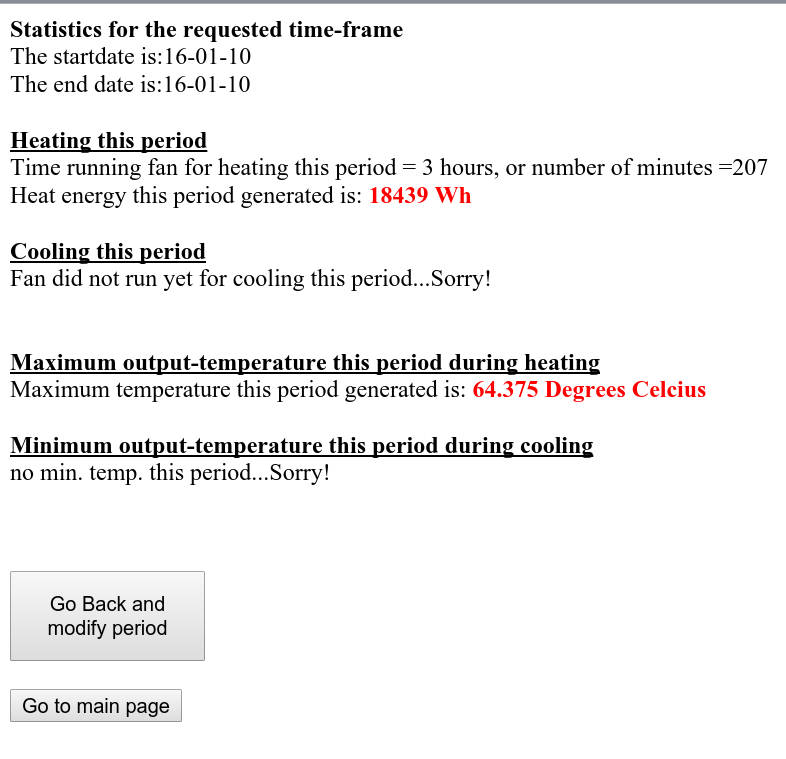Science corner
- Details
- Published on Sunday, 10 January 2016 20:16
- Hits: 9229
Here some science about the collector, and how performance is calculated.
First the fan that is used (It is actually used since 10th of January 2016, before it was a much smaller fan, with only a maximum of 100m3/h).
Below you can see the graph of the performance of the fan: It has 3 speeds, and the highest speed is used here.

Although it has quit some back pressure, I think it is a safe assumption the flow is around the 700m3 per hour.
The formule that is written in the PHP code (in the webpage period-stat.php) is calculated as follows:
The flow is 700m3/h, and therefore the flow is 11.67m3 per minute.
The total energy that the air transfers is 0.26Wh/m3, times the delta temperature, times the number of m3, for every minute.
So the total of heat transfer can be calculated by adding up the transfer of every minute in that time frame. It is a very big calculation, to fetch in the database every log (of every minute), calculate the transfer for that minute, add it to the total, and go to the next minute... Fortunately computers don't get tired, and a calculation for a month or even a year are not too long...
Below you can see an example of the controllers webpage after asking for the statistics of a day in Januari 2016, mid winter:

It is supposed to generate arount 18kWh in about 3.3 hours, on around 8m2. That would be about 600W per square meter... Probably a little optimistic, a number of remarks have to be made;
First of all it is very difficult to know what the power of radiation is of the sun, when it reaches the surface of the earth. The number I found on Wikipedia is 1120 W/m2 at the Zenith. Because the collector here is at an angle less steep (around 45 Degrees, while the sun is going around only between 15 and 20 Degrees in January) it means there is a loss of around 15% (calculate the cosinus of 30 Degrees) already. It leaves about 1000W of radiation from the sun.
The conclusion would be that the collector has an efficiency of 600W/1000W or around 60%. Not too bad.
Yet also another remark is to be made: Since the calculation here gives efficiency calculated from the difference between ongoing and outgoing temperature, it does not mean the kWh produced are all useful; The in-going temperature is not the temperature that my house already has. My living room has already around 19 DegC, not around 10 DegC (like the outside temperature). So the useful delta temperature was not between 11 and 64 DegC, but actually only between 19 and 64. So the really useful kWh are about 20% less...
Do not hesitate to drop me an email if I am missing something in my calculations!
Tolerances!
Something to say about the tolerances in the measurements: I think the measurements of the temperatures are really exact. They are recorded by DS1820 sensors, that communicate trough I2C digital bus communication. It means there is no tolerance introduced by analog signals over wirings. The sensor itself should have a tolerance of less then 0.5 DegC.
The timing of the recording then; Since the controller is connected to the internet and uses a NTP timeserver, it is save to say that the clock is very accurate, and it will never differ more then one or two seconds. Every minute one recording is written in the database, which includes timestamp, temperatures, mode and so on. No calculated values are recorded, so if shown they are calculated o the spot. The moment of writing within the minute can differ rather much, but that doesn't really has a negative effect on tolerances.
For the flow it is a different ballgame; The flow is not measured, and is based on a best guess based on the graph of the fan. The flow of the fan is rather stable above 700m3/h, but drops dramatically if there is more back pressure then 200 Pa. That I assume is the 'surge point' of the fan, where different sound is to be expected. By testing and blocking/unblocking the outlet, I would think there is no surging, and the flow is pretty sure above 700m3/h. It also means it could be more, up to over 900m3/h. so there is a big difference! Over all, I think that with these figures in mind the real difference could be up to maximum 15% in flow, and therefore in generated heat. And it could be in positive or negative way...




